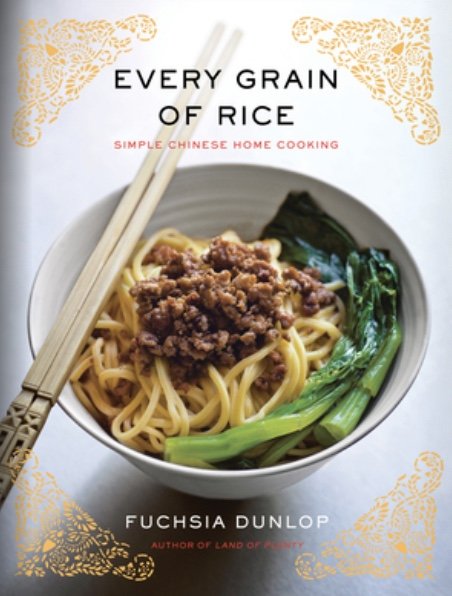Every Grain of Rice: Simple Chinese Home Cooking by Fuchsia Dunlop (W. W. Norton & Company)
A couple of centuries ago, a British diplomat decided the Chinese were “foul feeders and eaters of garlic and other strong-scented vegetables.” Even nowadays, when nutritionists extol the Mediterranean Diet, the Okinawa Diet, and the eating habits practiced by long-lived peasants of the Caucasus Mountains, “Chinese food” is firmly linked in the Western mind with MSG, cornstarch, and fortune cookies.
British writer Fuchsia Dunlop has spent much of her life debunking this misconception. A food anthropologist of sorts, she fell in love with the food of Sichuan when she was studying in Chengdu and went on to explore the varied cuisines of Chinese regional cooking. While concentrating on the food of Sichuan (Land of Plenty) and Hunan (Revolutionary Chinese Cookbook), Dunlop has traveled widely throughout China--and wherever she’s been, she’s talked to people about the food they eat and how they cook it. The result of her odyssey is embodied in Every Grain of Rice, a book that’s as much a work of travel literature and a health manual as it is an encyclopedia of recipes and cooking techniques.
Throughout Chinese history, people have been guided by the words of the philosopher Mencius, who advised “Do not disregard the farmer’s seasons and food will be more than enough,” two millennia before Michael Pollan ‘s famous maxim “Eat food. Not too much. Mostly plants.” During her travels, Dunlop, who comes from the land of boiled cabbage and mushy peas, is struck by the preponderance of vegetables in the dishes she eats, all of them made delicious by the flavors they’ve been given. From Beijing to Guangzhou and through the regions in between, meat and fish are used sparingly in everyday meals, almost as condiments that provide a side note of flavor. “It’s interesting,” Dunlop observes, “ to see how modern dietary advice often echoes the age-old precepts of the Chinese table: eat plenty of grains and vegetables and not much meat, reduce consumption of animal fats and eat very little sugar.” Spartan? Stringent? Time-consuming? Not at all. Dunlop describes food that takes “only fifteen minutes to make but is beautiful enough to launch ships,” “with flavors that still amaze me.”
The secret lies in buying fresh ingredients, collecting an arsenal of flavors to construct a Chinese pantry, which Dunlop carefully explicates, and mastering a few simple techniques which she shows step-by-step in clear photographs. Then the fun begins.
When was the last time you read a cookbook with an entire section devoted to leafy greens, another to garlic and chives? Have you ever prepared cucumbers or celery or radishes to take center stage in a hot dish? Or cooked with lily bulbs? Or used only two ounces of meat as part of a meal? Dunlop makes all of this enticing, easy, and healthful too--who knew?
As she finds food, she describes the beauty of the countryside: the piercing green of rice fields and bamboo groves in Zhejiang, the dizzying scent of osmanthus blossoms in Hangzhou where the blooms are gathered and used to sweeten meals, the mountainsides of Southern China where “every spare inch is sown with crops.” She tells how strangers happily share their recipes with her when she stops on the street to ask what they’re eating, with stories of the meals she ate while “hanging out with some artist friends and a bunch of local gangsters.” She delves into culinary history in a story of how pirates in centuries past decided who among a ship’s passengers was worth robbing by observing how their prospective victims ate fish. She’s clearly enchanted with the Chinese names for vegetables which turn kohlrabi into “jade turnip” and bean sprouts into “silver sprouts,” transform broccoli into “flower vegetables from the Southwest” and aptly call chard “ox leather greens.” And while she gives rice all the honor that is its due, she warns not to leave it out within four hours of it being cooked nor to keep it for more than three days after preparing it, even if it’s refrigerated. Food poisoning is a distinct possibility for those who ignore her advice.
Even potatoes, those mainstays of Western kitchens, take on a tempting new guise as stir-fried mashed potatoes with “snow vegetable” (preserved mustard greens), made in minutes from leftovers. For devotees of Westernized Chinese food such as the ubiquitous Kung Pao Chicken, Dunlop offers Gong Pao Chicken, the honest-to-god Sichuan original dish as it’s eaten in Chengdu--made with two chicken breasts and ingredients that bring tons of flavor.
Augmenting Dunlop’s recipes and stories are gorgeous photographs of almost every dish, taken by Chris Terry, each one guaranteed to send readers into their kitchens with a bunch of spinach or garlic scapes in hand. Bring on the Chinese Diet--and viva Fuchsia Dunlop!~Janet Brown
